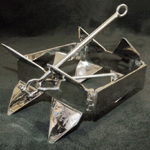Given that I’m the “boating guy” what I’m about to say may surprise you, but here goes—“Anchoring your boat can be almost as much fun as cruising.”
OK, Let me explain. It’s true that few activities can compare to being out on the water, zipping along enjoying the sunshine, watching the waves…you get the idea. But say you’d like to stop and go swimming. Or fishing. Or just relax and take in the scenery in a quiet cove while enjoying a day off with your friends and family. That’s when anchoring can be fun. The truth is, the ability to anchor your boat securely is a necessary boating skill. Anchoring can help you control your boat in bad weather or keep your boat secure if the engine has quit and the wind and currents are pushing you towards shore.
Anchors are made to burrow into the bottom. If the anchor is set right, the more your boat pulls on the anchor, the harder the anchor digs into the bottom. Choosing the right anchor has more to do with what’s under the water than the type of boat you have. For instance, some anchors work best in sandy bottoms, while others are made for grassy or muddy riverbeds.
Let’s look at some popular anchors and where to use them:
-
Pivoting steel fluke anchors are made to work in mud and sand. These are perhaps the most common anchors available. The pivoting steel fluke anchor has two steel points that dig into the bottom.
-
Plow anchors and Claw type anchors are similar to pivoting steel fluke anchors except the pointing part is stationary and hold your boat in rocks, weeds, and sand
-
Grapnel Anchors look like a grapneling hook and are used with small boats when water conditions are very mild.
-
Mushroom anchors do not have a lot of holding power and are generally used on skiffs, canoes, and inflatable boats
-
Land or Shoreline anchors are used when you want to secure a boat on the beach
Of course, to talk about anchoring, you need to learn the lingo. The anchor rode is the line —line being the nautical term for rope— that attaches the anchor to the boat. “Scope” is the term for the amount of rode you have out when you’re anchoring
-
An anchor rode is made up of a long length of line— I recommend nylon; it’s strong, stretches under a load and lasts a long time—several feet of chain and a couple of shackles to fasten the line, chain and anchor together.
How do you know how much rode you need? Simple mathematics. A good rule of thumb is to have anchor rode equal to 5-8 times the depth of water. Use a 5 to 1 scope for daytime anchoring and an 8 to 1 scope when anchoring at night.
For example—Say you are in 10 feet water, you would want your anchor line to be between 50 and 80 feet long. Or if you are in 50 feet water, you would need anchor line between 250 and 400 feet long.
That’s it for now. See you out on the water—Safe boating.
See Also:
